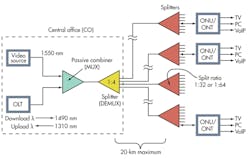Download this article in .PDF format
EPON and GPON are popular versions of passive optical networks (PONs). These short-haul networks of fiber-optical cable are used for Internet access, voice over Internet protocol (VoIP), and digital TV delivery in metropolitan areas. Other uses include backhaul connections for cellular basestations, Wi-Fi hotspots, and even distributed antenna systems (DAS). The primary differences between them lie in the protocols used for downstream and upstream communications.
Passive Optical Networks
A PON is a fiber network that only uses fiber and passive components like splitters and combiners rather than active components like amplifiers, repeaters, or shaping circuits. Such networks cost significantly less than those using active components. The main disadvantage is a shorter range of coverage limited by signal strength. While an active optical network (AON) can cover a range to about 100 km (62 miles), a PON is typically limited to fiber cable runs of up to 20 km (12 miles). PONs also are called fiber to the home (FTTH) networks.
The term FTTx is used to state how far a fiber run is. In FTTH, x is for home. You may also see it called FTTP or fiber to the premises. Another variation is FTTB for fiber to the building. These three versions define systems where the fiber runs all the way from the service provider to the customer. In other forms, the fiber is not run all the way to the customer. Instead, it is run to an interim node in the neighborhood. This is called FTTN for fiber to the node. Another variation is FTTC, or fiber to the curb. Here too the fiber does not run all the way to the home. FTTC and FTTN networks may use a customer’s unshielded twisted-pair (UTP) copper telephone line to extend the services at lower cost. For example, a fast ADSL line carries the fiber data to the customer’s devices.
The typical PON arrangement is a point to multi-point (P2MP) network where a central optical line terminal (OLT) at the service provider’s facility distributes TV or Internet service to as many as 16 to 128 customers per fiber line (see the figure). Optical splitters, passive optical devices that divide a single optical signal into multiple equal but lower-power signals, distribute the signals to users. An optical network unit (ONU) terminates the PON at the customer’s home. The ONU usually communicates with an optical network terminal (ONT), which may be a separate box that connects the PON to TV sets, telephones, computers, or a wireless router. The ONU/ONT may be one device.
In the basic method of operation for downstream distribution on one wavelength of light from OLT to ONU/ONT, all customers receive the same data. The ONU recognizes data targeted at each user. For the upstream from ONU to OLT, a time division multiplex (TDM) technique is used where each user is assigned a timeslot on a different wavelength of light. With this arrangement, the splitters act as power combiners. The upstream transmissions, called burst-mode operations, occur at random as a user needs to send data. The system assigns a slot as needed. Because the TDM method involves multiple users on a single transmission, the upstream data rate is always slower than the downstream rate.
GPON
Over the years, various PON standards have been developed. In the late 1990s, the International Telecommunications Union (ITU) created the APON standard, which used the Asynchronous Transfer Mode (ATM) for long-haul packet transmission. Since ATM is no longer used, a newer version was created called the broadband PON, or BPON. Designated as ITU-T G.983, this standard provided for 622 Mbits/s downstream and 155 Mbits/s upstream.
While BPON may still be used in some systems, most current networks use GPON, or Gigabit PON. The ITU-T standard is G.984. It delivers 2.488 Gbits/s downstream and 1.244 Gbits/s upstream.
GPON uses optical wavelength division multiplexing (WDM) so a single fiber can be used for both downstream and upstream data. A laser on a wavelength (λ) of 1490 nm transmits downstream data. Upstream data transmits on a wavelength of 1310 nm. If TV is being distributed, a wavelength of 1550 nm is used.
While each ONU gets the full downstream rate of 2.488 Gbits/s, GPON uses a time division multiple access (TDMA) format to allocate a specific timeslot to each user. This divides the bandwidth so each user gets a fraction such as 100 Mbits/s depending upon how the service provider allocates it.
The upstream rate is less than the maximum because it is shared with other ONUs in a TDMA scheme. The OLT determines the distance and time delay of each subscriber. Then software provides a way to allot timeslots to upstream data for each user.
The typical split of a single fiber is 1:32 or 1:64. That means each fiber can serve up to 32 or 64 subscribers. Split ratios up to 1:128 are possible in some systems.
As for data format, the GPON packets can handle ATM packets directly. Recall that ATM packages everything in 53-byte packets with 48 for data and 5 for overhead. GPON also uses a generic encapsulation method to carry other protocols. It can encapsulate Ethernet, IP, TCP, UDP, T1/E1, video, VoIP, or other protocols as called for by the data transmission. Minimum packet size is 53 bytes, and the maximum is 1518. AES encryption is used downstream only.
The latest version of GPON is a 10-Gigabit version called XGPON, or 10G-PON. As the demand for video and over the top (OTT) TV services has increased, there is an increasing need to boost line rates to handle the massive data of high-definition video. XGPON serves this purpose. The ITU standard is G.987.
XGPON’s maximum rate is 10 Gbits/s (9.95328) downstream and 2.5 Gbits/s (2.48832) upstream. Different WDM wavelengths are used, 1577 nm downstream and 1270 nm upstream. This allows 10-Gbit/s service to coexist on the same fiber with standard GPON. Optical split is 1:128, and data formatting is the same as GPON. Maximum range is still 20 km. XGPON is not yet widely implemented but provides an excellent upgrade path for service providers and customers.
EPON
The Institute of Electrical and Electronic Engineers (IEEE) developed another newer PON standard. Based on the Ethernet standard 802.3, EPON 802.3ah specifies a similar passive network with a range of up to 20 km. It uses WDM with the same optical frequencies as GPON and TDMA. The raw line data rate is 1.25 Gbits/s in both the downstream and upstream directions. You will sometimes hear the network referred to as Gigabit Ethernet PON or GEPON.
EPON is fully compatible with other Ethernet standards, so no conversion or encapsulation is necessary when connecting to Ethernet-based networks on either end. The same Ethernet frame is used with a payload of up to 1518 bytes. EPON does not use the CSMA/CD access method used in other versions of Ethernet. Since Ethernet is the primary networking technology used in local-area networks (LANs) and now in metro-area networks (MANs), no protocol conversion is needed.
There is also a 10-Gbit/s Ethernet version designated 802.3av. The actual line rate is 10.3125 Gbits/s. The primary mode is 10 Gbits/s upstream as well as downstream. A variation uses 10 Gbits/s downstream and 1 Gbit/s upstream. The 10-Gbit/s versions use different optical wavelengths on the fiber, 1575 to 1580 nm downstream and 1260 to 1280 nm upstream so the 10-Gbit/s system can be wavelength multiplexed on the same fiber as a standard 1-Gbit/s system.
Summary
Telecommunications companies use PONs to provide triple-play services including TV, VoIP phone, and Internet service to subscribers. The benefit is much higher data rates that are essential to video distribution and other Internet services. The low cost of passive components means simpler systems with fewer components that fail or require maintenance. The primary disadvantage is the shorter range possible, commonly no more than 20 km or 12 miles. PONs are growing in popularity as the demand for faster Internet service and more video grows. GPON is the most popular in the U.S., such as Verizon’s Foist system. EPON systems are more prevalent in Asia and Europe.
Download this article in .PDF format
References
- Frenzel, Louis, Principles of Electronic Communications Systems, McGraw Hill, 2008.
- Lippi, Nicholas, GPON vs. Gigabit Ethernet in Campus Networking, February 2012.
- Trots, Joe, An Overview of GPON in the Access Network, presentation for Ericsson, November 2008.

